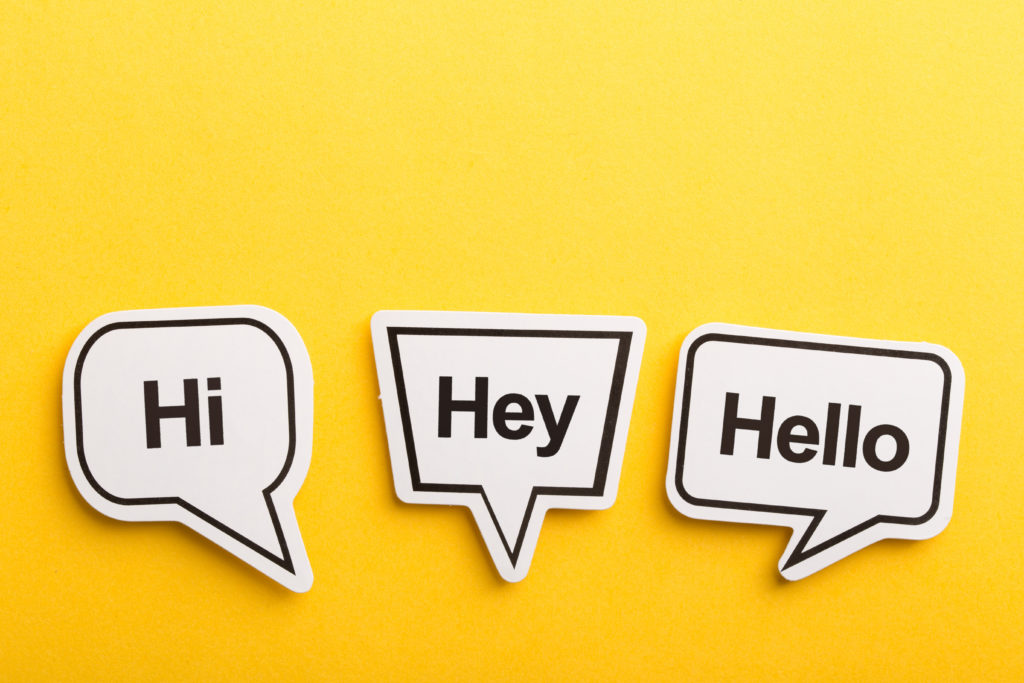Hello lovely students! Are you bored of simply saying hello? Do you wish to introduce yourself by using different words? Then we have got you covered. Read this helpful article on introducing yourself with scenarios from job interviews all the way to networking events.
You’ll be a pro in no time.

The non-verbal
Body language
First things first, body language. First impressions are EVERYTHING, regardless of what language you speak. When you meet someone for the first time, you want to give off the impression that you are open. That way, when you start talking to them, they’ll feel more comfortable with you.
This can lead to many open doors.
Some good pointers for positive body language include: smiling, eye contact, and keeping your body relaxed.

Hands
What you do with your hands when you meet someone for the first time depends on the context and the culture.
Generally speaking, if you are in a professional situation you must give the other party a handshake. A handshake is done with your right hand and the other person’s right hand and involves joining them together for an extremely short time whilst moving them up and down.
The unwritten rule of a handshake is to go up and down twice, to keep it somewhat firm and to let go of the other person’s hand immediately after. You might seem a bit strange if you keep holding their hand.
In a casual scenario, it’s a bit different. You would seem odd shaking someone’s hand, although this is very culture specific. In a lot of countries, it is common to kiss the cheeks of people you are meeting for the first time.
Please do not do this in the UK. We are fairly reserved and kissing cheeks would be seen as unusual by most people from here. Instead, just simply wave. It’s an entirely appropriate greeting.
Now that we’ve got the main points covered for what we do with our bodies, let’s move on to words.

The verbal
Words are a huge part of life, and introductions are no different. See below for how to introduce yourself casually and how to introduce yourself professionally.
Casual introductions
Greetings
The first thing you should do, in any situation, is greet the person you are about to talk to. It would be very strange if you did not.
Hello is probably one of the greetings you’re most used to. However, there are so many more that you should know about that are in this table.
| Hi | Hiya |
| Good morning | Good evening |
| Good afternoon | Yo |
| What’s up | ‘sup |
| Hey | Ey up |
Please note, ‘sup, what’s up, yo and ey up and often more reserved for friends and people you have an extremely good relationship with.
Oddly enough, we do sometimes say ciao and bonjour which are from Italy and France respectively.
When we meet someone for the first time, we tend to say nice to meet you. However, if we have heard a lot of things about the person we are talking with, we say I’ve heard a lot about you or we meet at last.
How are you?
After we have said hello, we then follow up with questions such as how are you?, to see how the person is doing. Other synonyms for how are you? Include the following:
- How are you doing?
- How have you been?
- How’s everything?
- How’s it going?
- How are things going?
- What’s going on?
- What’s new?
- What are you up to?
Now before we look at the typical responses to how are you?, there are two very important cultural rules to be aware of.
- In the UK, we often say hey, how are you? as a greeting without expecting a response. This might seem confusing at first, but trust me it happens.
- Never ask how are you? when greeting someone in the United States. They assume you are asking them how they are because they think you think they are upset.
- Even if you are feeling terrible, never respond in such a way when in the UK. It is not common for us to express our feelings to people as soon as we meet them. Reserve that for close friends and family.
Anyway, now that I have touched on responses to how are you?, let’s take a look at some good ones.
| I’m well | I’m fine |
| I’m all good | I’m grand |
| Yeah, everything is going well | Life is peachy |
| I’m ticking along* | I’m hanging on in there* |
*These two are usually used if you feel bad but do not want to say it.
We usually follow these up with thanks for asking and then with our names.
We can say our names by saying: I’m + your name or my name is + your name.
We then proceed to ask the other person how they are.
A typical short introduction conversation for someone you have never heard of before looks like this.
A: Hello, how are you? My name’s john.
B: Hi John, nice to meet you, I’m Daisy. How are you?
A: I’m good thanks. How are you?
B: Yeah, I’m good too, thanks for asking.
For someone you haven’t met but have heard of, the conversation looks a bit like this.
A: Hi, we meet at last/ I have heard a lot about you from a mutual friend. I’m John. How are you?
B: Hi John, good to meet you too. I’m Daisy. I’m all good, how about you?

Questions after the initial introduction
Obviously, the conversation doesn’t just stop there. It would be very short if it did and probably wouldn’t give off a good first impression.
Other things to ask would be where the person lives, what they do and what they like. Avoid asking questions about family and age unless the other person is open to conversation because it could be fairly sensitive.
Let’s take a look at some generic questions and their responses.
Where do you live?
Other synonyms include: are you from around here? or whereabouts are you from?
If you live nearby to where you meet, you can respond with just up the road.
You can also say I was born and raised in + the name of the town.
I was born and raised in Chelmsford.
However, if you grew up somewhere different to where you live you can say the following:
I was born and raised in (your hometown) but I moved to (your new town) + (a length of time) ago.
I was born and raised in Chelmsford but I moved to Bristol two months ago.
I grew up in (old town) but I live in (new town).
I grew up in Chelmsford but I live in Bristol.
I’m originally from (old town) but I’m based in (new town).
I’m originally from Chelmsford but I’m based in Bristol.
What do you do?
What do you do? is synonymous with what is your job/area of study?
If you are a student, respond with I’m a (subject student) at (university).
I’m a maths student at the University of York.
If you’re a worker, you respond a bit differently.
I work in (job field).
I work in marketing.
I work as a/an (position) at/for (company)
I work as a technician at/for Google.
I’m a/an (position).
I’m a developer.
What do you like doing?
This is the same as what are your hobbies? or what do you get up to in your free time?
I really like + gerund.
I really like swimming.
I really enjoy + gerund.
I really enjoy playing football.
I’m a big fan of + noun/gerund.
I’m a big fan of theatre.
I’m a big fan of singing.
I’m keen on + noun/gerund.
I’m keen on dancing.
I’m keen on books.
Note: we can omit the word really from the first two examples. It is just used for emphasis.

Age and family
If the person you are talking to does end up asking you about your age and your family, and you feel comfortable answering, look at these responses.
How old are you?
These are typical responses to these questions.
I’m (number) years old.
I’m 25 years old.
I’m (age).
I’m 29.
If you don’t want to give an exact age, you can say the following instead.
I’m in my early/mid/late + decade.
I’m in my late twenties.
I’m in my early thirties.
How many people are in your family?
This is a question that most people would want to know but perhaps wait until a little bit later to ask. You can say these phrases.
I’m from a family of (insert number).
I’m from a family of six.
This means you have six members in your immediate family.
You can make the number higher if you want to include your extended family such as cousins, aunts and uncles.
I’m from a family of 26 including my extended family.
If you are talking about your brother or sisters you can say:
I have four brothers.
I have four sisters.
I have four siblings .
Note: sibling is gender-neutral and means brothers and sisters combined. It is useful to say instead of I have two sisters and one brother.
Another way to say this in a more general sense is I am one of four.
Goodbye
Now that your conversation is over, how do you say goodbye in a casual setting?
Of course, you can simply say bye, but if the conversation went well, perhaps try something a bit more open. Have a look at the table below.
| See you later | See ya |
| Take it easy | Let me know when you’re around and we can hang out |
| Take care | Don’t be a stranger |
| Have a good one (this often refers to the rest of the day) | Until next time |
| See you around | Bye bye |
Mock conversation
Now that you know the words and phrases to use for a casual conversation, let’s take a peek at an example .
John: Hi there, how are you doing? I’m John.
Daisy: Hi John, nice to meet you at last, I’ve heard a lot of things from our mutual friend Sven. I’m Daisy. Had a very busy week but apart from that, all is well thanks for asking. How are you doing?
John: I’m all good too. I don’t think I’ve seen you around town before. Do you come from around here?
Daisy: Yes and no. I’m originally from here, and I lived here until I was two, but since then I’ve been based in Glasgow.
John: Nice. What do you do?
Daisy: I’m an estate agent at a chain called Houses We Sell. What about you?
John: I’m from here, born and raised. I work at the mechanic shop down the road.
Daisy: Cool. What do you like doing in your free time?
John: I’m not a big sports fan, but I am keen on cooking. I really like making food. How about you?
Daisy: I don’t have many hobbies. I like socialising with friends though.
John: Yeah me too. Well, I have to leave now. Nice chatting with you. See you around.
Daisy: Same here. See you later.
Note: we use questions like how about you? and what about you? after an answer to avoid repeating the same question that was asked to us.
Now that you have learned all about casual introductions and how to converse naturally, let’s learn about how to introduce yourself professionally.

Professional introductions
Perhaps the scariest part of introductions is when you introduce yourself professionally. Talking professionally can be the difference between job seekers landing their dream job and giving a lasting positive impression or not getting a promotion and a new job title.
Professional introductions are completely different to casual ones.
Usual professional settings for when you introduce yourself include job interviews, networking events, and even elevator pitches (which is when you present an idea or product in a short period to a higher manager such as a project manager or marketing director). There are many creative ways to do this, but perhaps the most important part is to give off a sense of confidence. Let’s look at some tips.

Tips to make you seem confident in a professional context.
1) Eliminate negative language – this is very important, especially in a job interview. You want to make sure you focus on your successes, relevant information, and key points in your career/study and nothing else.
2) Boost your knowledge – before you go to a networking event or job interview make sure you know who is going, what the networking event is for and interesting facts about your field of work/study
3) Be digital – yes this one seems strange, but if you’re going to a professional event then a professional introduction over social media makes it a lot easier to know who is who before going to the event. Simply saying something along the lines of “heading over to x event. If anyone else is going, let me know here.
Not only is this a good way to build relationships and new connections, but practically you may have to carry one less business card pack around with you as everyone will have your information digitally.
Greetings
A typical way to introduce yourself professionally would be by saying these words.
Hello, good morning, good afternoon and good evening, depending on the time of day.
There are fewer options in this category, simply because we want to remain professional.
How are you?
How are you? is commonly used in professional settings, shortly followed by a pleasure to meet you.
Responses are fairly short and stick to I am fine thank you, and how are you?
Other questions
Other questions in professional settings tend to be a bit less open than questions in informal settings. They typically centre around education and qualifications. Let’s take a look at some questions and responses.
Education
Where did you study?
When people ask this they often mean what university did you study at? It is always good to respond to this with the university and course you attended or are attending.
You can reply I studied (subject) at x university or I am studying (subject) at x university if you are still a university student.
I studied biology at Keele University.
I am studying physics at Newcastle University.
If you didn’t go to university you can respond by saying I studied at x school. I didn’t go to university as I wanted to go straight to work.
I studied at Miller school. I didn’t go to university as I wanted to go straight to work.
Both are just as impressive as each other.
What grade did you get?
Again, this often refers to what grade you got at university.
You can simply say I achieved a + (your grade).
I achieved a 2:1.
If you didn’t go to university, you can respond by saying an average of your grade or, if you got the same grades in every subject, you can say I got (subject grade) across the board.
I got a’s across the board in school.
If you have no formal qualifications from school, you can simply say this: I haven’t got any school qualifications, but I do have plenty of experience.

Work
You will also get asked about your experience at work. The question is normally asked as What experience do you have? and What is your field/area of work?
You can reply like this.
I have (number) years of experience in the (occupation) field.
I have three years of experience in the sales field.
I have (number) years of (occupation) experience.
I have three years of sales experience.
I have worked in (occupation) for (number) years.
I have worked in sales for three years.
I’m a/an (job title) for (company) and I have worked in (occupation) for (number).
I’m a sales rep for Apple and I have worked in sales for three years.
Now you may also be asked about where you come from and your hobbies. You can respond in the same way as the examples given above in the casual introduction section.
Goodbye in a professional introduction
There are two ways to say goodbye in a professional introduction:
It was lovely to meet you, goodbye.
Thanks for your time, goodbye. – this is good when in a job interview.
Mock conversation
Now that we have seen how to have a conversation, let’s take a look at an example of a scenario at a networking event.

Professional 1: Hello, nice to meet you. My name’s Jan. How are you?
Professional 2: Hello Jan, nice to meet you too. I’m Steve. I’m well, thanks for asking and hope you are too.
Professional 1: Yes, I’m fine thanks.
Professional 2: So, what is your field of work?
Professional 1: I’m an accountant for Google and I have worked in accounting for 10 years. What about you?
Professional 2: I have worked in IT for six years now, mainly as a freelancer.
Professional 1: Oh, nice. Where did you study?
Professional 2: I studied at Cardiff university. Where did you study?
Professional 1: I didn’t go to university, but I did get my diploma in accounting. I wanted to go to work after school.
Professional 2: Well, I must be going. It was nice to meet you. Goodbye.
Professional 1: You too. Goodbye.
Remember that this is a template of a conversation.
Is that everything?
Absolutely not!. I hope you have learnt a lot from this article on how to introduce yourself. The most important thing though, overall, is just to be yourself. For more tips and tricks, watch the video below on my channel, English with Lucy.